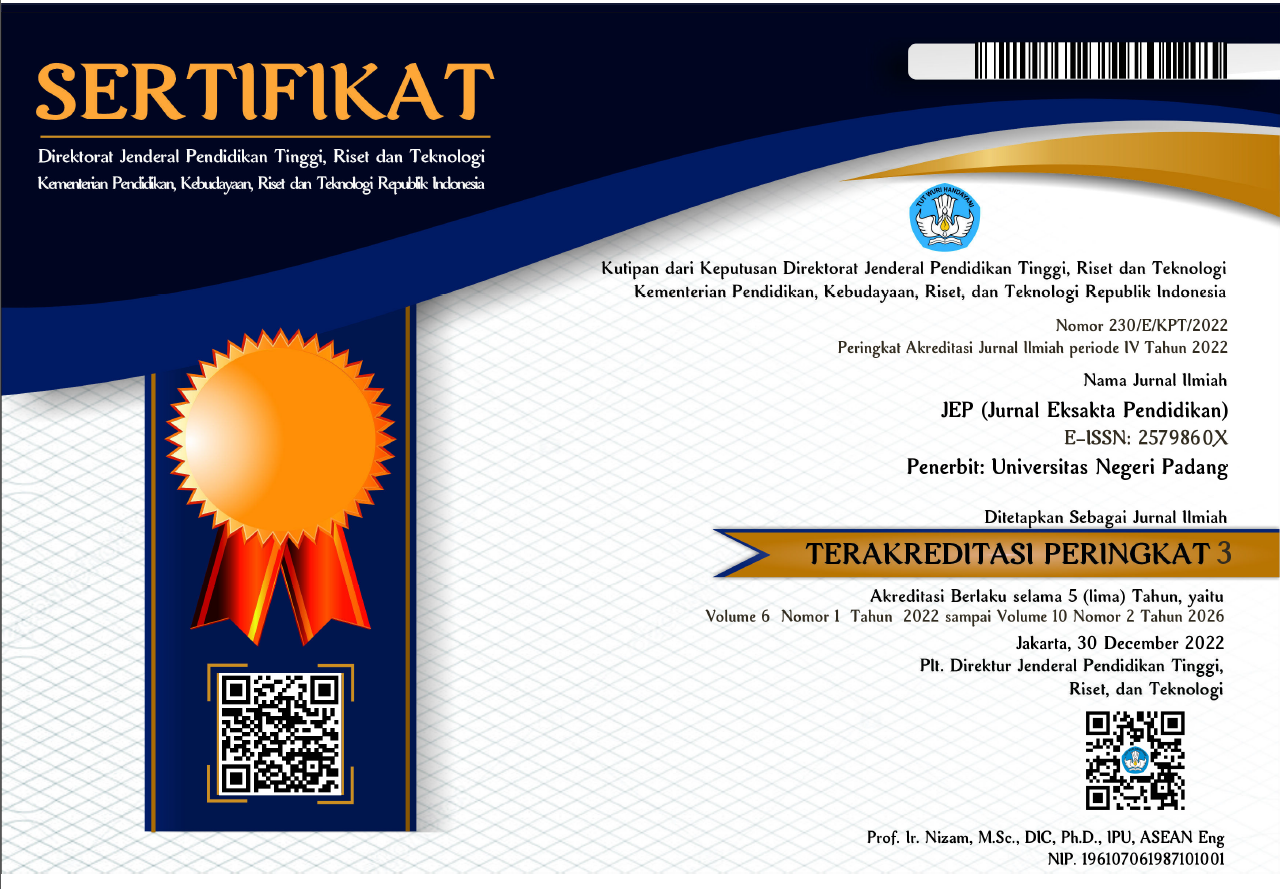Efektivitas Implementasi Pendekatan Scientific dengan Model Problem Based Learning dan Learning Cycle 5E
Abstract
The purposes of this research are to describe and compare the effectiveness of the imple mentation of scientific approach using problem based learning and learning cycle 5E model viewed from achievement spiritual attitudes, social attitudes, knowledge, and skills of students on polyhedral topic in Junior High School Grade VIII. This research is quasi experiment using nonequivalent (pre-test and post-test) group design. Population in this research are all of students grade VIII Junior High School 12 Padang. The sample was grade VIII4 and VIII5. The instruments used are questionnaires spiritual attitude and social attitude, knowledge and skill test. The results of the research are as follows the implementation of scientific approach with problem based learning and learning cycle 5E model is effective viewed from the achievement spiritual attitudes, social attitudes and knowledge of students, but not effective viewed from students skill, and there are no differences between the effectiveness of the implementation of scientific approach using problem based learning and learning cycle 5E model.
Downloads
References
Allen, M. J. & Wendy M. Yen. (1979). Intro duction to Measurement Theory. Belmont, California: Wadsworth, Inc.
Arends, R.I., & Kilcher, A. (2010). Teaching for Student Learning Becoming an Accomplish Ed Teacher. Madison Avenue, New York: Routledge.
Azwar, S. (2013). Tes prestasi. Fungsi dan Pengembangan Pengukuran Prestasi Bela Jar. Yogyakarta: Pustaka Pelajar.
Choerudin, A. (Agustus 2015). The Role of Spirituality An Employee to Organi zations Business: A Review. International Journal of Information, Business and Management, 7 (3), 191-199.
Ebel, R.L., & Frisbie, D.A. (1991). Essentials of Educational Measurement (5th ed). Engle wood Cliffs, NJ: Prentice-Hall, Inc.
Fathurrohman, P., Suryana, AA., & Fatriany, F. (2013). Pengembangan Pendidikan Karak ter. Bandung: Refika Aditama.
Hosnan, M. (2014). Pendekatan Saintifik dan Kontekstual dalam Pembelajaran Abad 21 Kunci Sukses Implementasi Kurikulum 2013. Jakarta: Ghalia Indonesia.
Jun, W. H., et al. (2013). Use of the 5e Learning Cycle Model Combined with Problem-Ba sed Learning For A Fundamentals of Nursing Course. Journal of Nursing Education, 52 (12), 681-689.
Kemendikbud. (2013). Peraturan Menteri Pendi dkan dan Kebudayaan Nomor 81 A Tahun 2013 Tentang Implementasi Kurikulum 2013.
Kemendikbud. (2014). Peraturan Menteri Pen didikan dan Kebudayaan Nomor 58 Tahun 2014 Tentang Kerangka Dasar dan Struktur Kurikulum Sekolah Mene ngah.
Luquis, R.R., Brelsford, G.M., & Rojas-guyler, L. (September 2012). Religiosity, Spiri tuality, Sexual Attitudes, and Sexual Beha Viors Among College Students. Journal of Religion and Health, 51 (3), 601-614.
Manda, T. G. (2012). Pemahaman Konsep Luas dan Volume Bangun Ruang Sisi Datar Sis wa Melalui Penggunaan Model Learning Cycle 5E Disertai Peta Konsep. Jurnal Pen didikan Matematika, 1(1).
Marczyk, G., DeMatteo, D., & Festinger, D. (2005). Essentials of Research Design and Methodology. Hoboken, New Jersey: John Wiley & Sons, Inc.
Mardapi, D. (2012). Pengukuran Penilaian & Evaluasi Pendidikan. Yogyakarta: Nuha Medika.
McElmeel, S.L. (2002). Character Education: a Book Guide for Teachers, Librarians, and Parents. Greenwood Village, Colorado: Greenwood Publishing Group, Inc.
Nowotny, H. (2008). Insatiable Curiosity. Inno vation in a Fragile Future. (Terjemah an Mitch Cohen). Cambridge, Massachusett s: The MIT Press. (Buku asli diterbitkan tahun 2005).
Rowson, J. (2012). The Power of Curiosity, How Linking Inquisitiveness to Innovation Could Help to Address Our Energy Challenges. London: RSA Social Brain Centre.
Souza, M., Durka, G., Engebretson, K., et al. (2009). International Handbook of The Religious, Moral, and Spiritual Dimen sions in Education: Part One, 183-200. Dor drecht, Netherlands: Springer.
Stevens, J. (2009). Applied Multivariate Statis tics for The Social Sciences. Madison Ave nue, New York: Rouletdge.
Stevenson, N. (2006). Young Person’s Charac ter Education Handbook. Otis Avenue, India na polis: JIST Publishing, Inc.
Sungur, S. & Tekkaya, C. (Juni 2006). Effects of Problem Based Learning and Traditional In Struction on Self-Regulated Learning. Journal of Education Research, 99 (5), 307-317.
Tuna, A. & Kacar, A. (Januari 2013). The Effect of 5E Learning Cycle Model in Teaching Trigonometry on Students’ Academic Achievement and The Permanence of Their Knowledge. International Journal on New Trends in Education and Their Implications, 4 (1), 73-87.
Ulas, A.H., Sevim, O., & Tan, E. (2011). The Effect of Worksheets Based Upon 5e Learning Cycle Model on Student Success in Teaching of Adjectives as Grammatical Components. Procedia: Social and Behavioral Science, 31(2012), 391-398.
Usmadi, U., & Ergusni, E. (2019). Penerapan Strategi Flipped Classroom dengan Pende katan Scientific dalam Pembelajaran Ma tematika pada Kelas XI SMKN 2 Padang Panjang. Jurnal Eksakta Pendidikan (JEP), 3 (2), 192-199.
Copyright (c) 2021 Trysa Gustya Manda, Marsigit Marsigit

This work is licensed under a Creative Commons Attribution 4.0 International License.

This work is licensed under a Creative Commons Attribution 4.0 International License.




_(2579-860X).png)
_(2614-1221)1.png)




